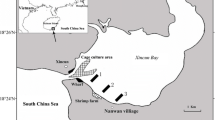Abstract
Silt and clay fractions and hydrographic data indicate that the silt/clay ratios depend on topographically controlled currents, water inflows, terrigenous input, and benthonic activities. The deep subbasins of the Marmara Trough with low-energy conditions show the lowest silt/clay ratios (0.2–0.4). The silt/clay ratios in the Çanakkale Strait (1.0–1.7) decrease markedly at the exit to the Aegean Sea (0.5–0.9) due to flow into a larger basin and the resultant lower current speed. Overall, under high-energy conditions the clay sediments cannot settle and are swept away, resulting in high silt/clay ratios.
Similar content being viewed by others
Author information
Authors and Affiliations
Rights and permissions
About this article
Cite this article
Ergin, M., Bodur, M.N. Silt/clay fractionation in surficial Marmara sediments: implication for water movement and sediment transport paths in a semi-enclosed and two-layered flow system (northeastern Mediterranean Sea). Geo-Marine Letters 18, 225–233 (1998). https://doi.org/10.1007/s003670050072
Received:
Revised:
Issue Date:
DOI: https://doi.org/10.1007/s003670050072




